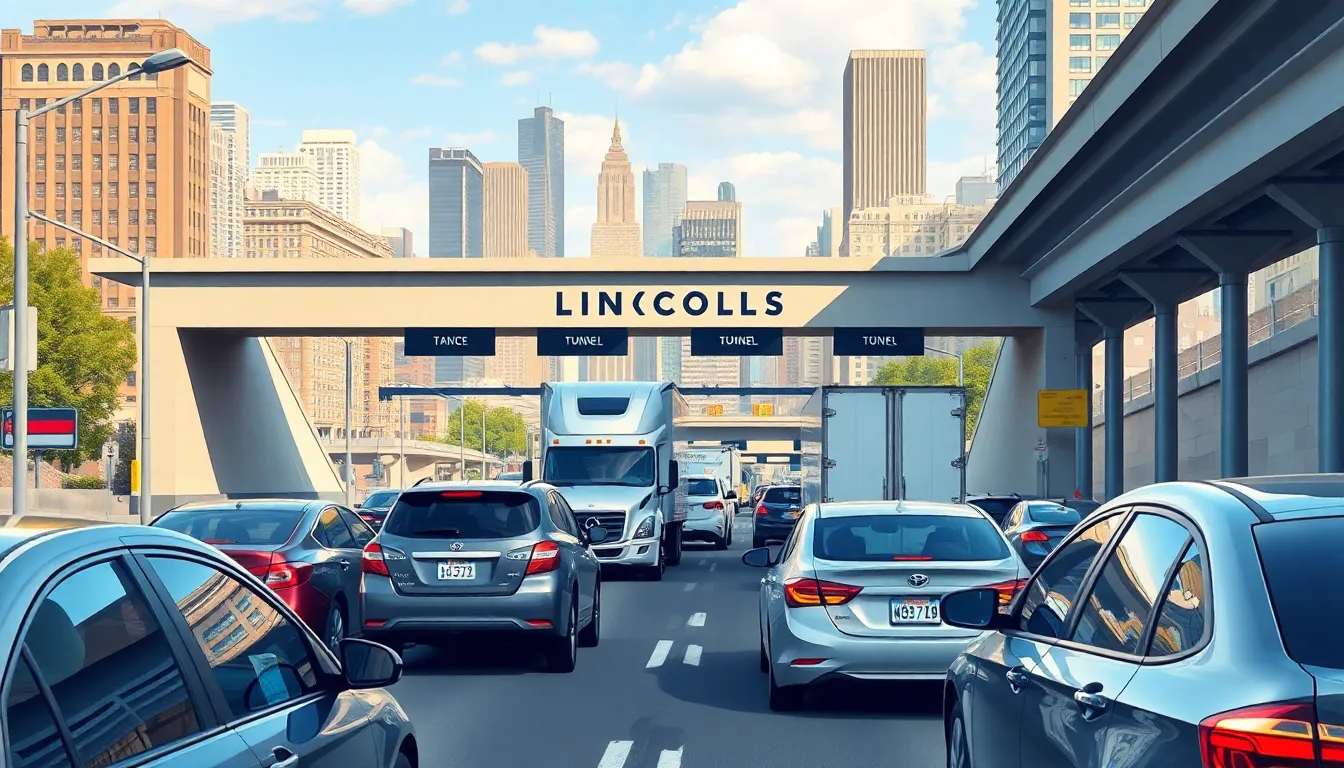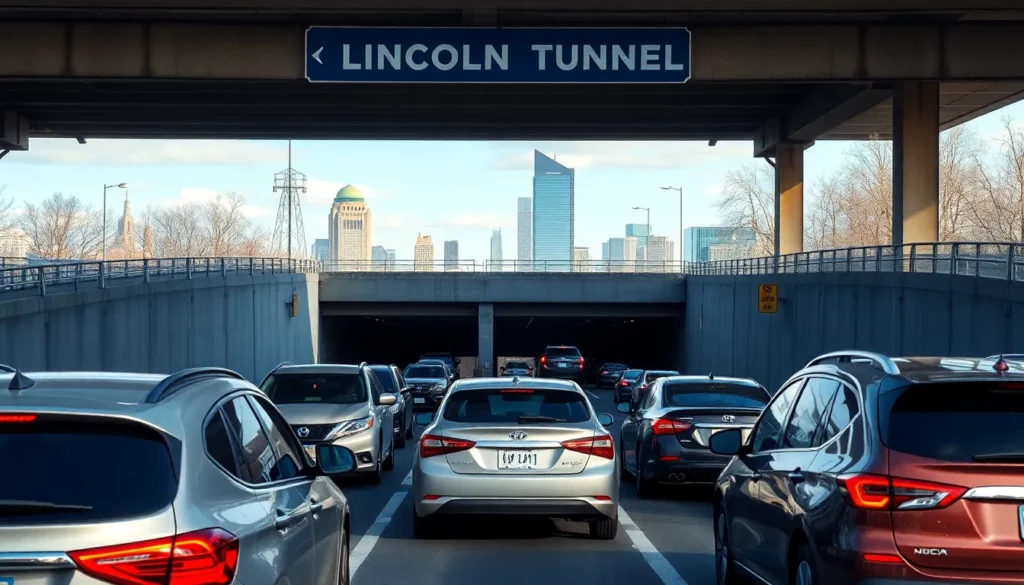Navigating the bustling streets of New York City can feel like a game of Frogger, and if you’re planning to cross the Lincoln Tunnel, you might want to check your wallet first. The toll isn’t just a minor inconvenience; it’s a ticket to an underground adventure that connects New Jersey to Manhattan.
Table of Contents
ToggleOverview of the Lincoln Tunnel
The Lincoln Tunnel serves as a vital connection between New Jersey and Manhattan. Constructed in the early 1930s, the tunnel stretches approximately 1.5 miles and comprises three vehicular tubes. Each tube accommodates a substantial volume of traffic daily, supporting commuters and travelers alike.
Navigating through the tunnel requires a toll, which varies based on several factors. As of October 2023, the toll for passenger vehicles is $16 during peak hours and $12 during off-peak hours when using E-ZPass. Commercial vehicles face higher rates, depending on their size and weight classification.
Traffic congestion often characterizes the Lincoln Tunnel, especially during rush hours. Travelers can expect significant delays, particularly on weekdays. Utilizing real-time traffic apps may help in planning trips more efficiently.
Accessibility features exist within the Lincoln Tunnel, accommodating individuals with disabilities. Amenities include designated parking areas and assistance for those who require support. Additionally, there are emergency services positioned strategically throughout the tunnel for added safety.
Overall, understanding the toll structure and expected traffic patterns can enhance the travel experience. Knowing these details can aid in making informed decisions when planning a trip through this critical transit route.
Toll Rates for the Lincoln Tunnel

Toll rates for the Lincoln Tunnel vary based on vehicle type and time of day. Traffic through this key connection influences the fees.
Cars and Motorcycles
Passenger cars face a toll of $16 during peak hours and $12 during off-peak hours when using E-ZPass. Vehicles that opt for cash payments incur higher rates, reflecting the convenience of electronic toll collection. Motorcycles also incur the same $12 rate during off-peak periods, while peak hours increase their toll to match car rates. Daily traffic patterns reveal that weekends may offer slightly lower congestion, potentially impacting travel times and overall costs. Knowing these rates benefits commuters planning their trips.
Trucks and Buses
Commercial vehicles, including trucks and buses, encounter higher tolls determined by size and weight class. Toll rates range from $16 to $32, depending on the vehicle’s classification. Apart from size, buses typically pay a flat rate of $32 regardless of passenger count. Larger trucks can incur additional fees, particularly during heightened traffic conditions. Planning for potential delays is essential, especially during busy periods. Understanding these charges aids businesses and drivers in managing costs effectively.
Payment Methods for the Lincoln Tunnel Toll
Travelers have several options to pay the Lincoln Tunnel toll. Understanding these methods ensures a smoother journey through this busy corridor.
Cash Payments
Cash payments for the Lincoln Tunnel toll are available, though this method can lead to longer wait times. The toll for passenger vehicles using cash stands at $16 during peak hours and $13 during off-peak hours, creating a noticeable difference compared to electronic options. Commercial vehicles also incur higher rates, with fees ranging from $16 to $32 based on size and weight. Given the increasing push for efficiency, cash lanes may experience congestion, especially during rush hours. Therefore, travelers should plan for potential delays when choosing this payment method.
Electronic Toll Collection
Electronic toll collection simplifies the payment process significantly. Using E-ZPass offers reduced toll rates of $12 during off-peak hours and $16 during peak hours for passenger vehicles. Commercial vehicles benefit from specific rates determined by size and weight, making E-ZPass a more economical choice. This method enhances travel efficiency by allowing drivers to pass through toll booths without stopping. Real-time data suggests that drivers who utilize E-ZPass often experience shorter wait times, particularly during high-traffic periods. Opting for electronic payment methods like E-ZPass can lead to a quicker, hassle-free experience.
Factors Affecting Toll Rates
Toll rates for the Lincoln Tunnel depend on a few key factors. Time of day plays a significant role in determining costs. During peak hours, passenger vehicles incur a $16 charge with E-ZPass and $16 for cash payments. Off-peak hours lower the E-ZPass rate to $12, but cash transactions still encounter a $13 toll.
Vehicle type also influences toll expenses. Passenger cars and motorcycles face the same rates, while commercial vehicles‘ charges vary. Trucks and buses pay between $16 to $32 based on their size and weight, with buses typically hitting the flat rate of $32. This variability impacts businesses transporting goods through the tunnel.
Payment methods additionally affect toll rates. E-ZPass promotes a quicker and more economical option, reducing costs and wait times. Toll rates for E-ZPass users differ compared to cash transactions, making it a preferred choice for frequent travelers. Longer wait times linked to cash payments can lead to added frustration, especially during busy hours.
Seasonality influences traffic flow, which can affect toll rates. Weekends often yield slightly decreased congestion, providing a smoother travel experience and potentially less spending. Awareness of external factors like weather conditions also plays a role, as heavy rain or snow can lead to altered traffic patterns and delays.
Understanding these factors enhances trip planning for both commuters and commercial drivers. By considering the time of travel, vehicle type, payment method, and seasonal variations, they can optimize their journey through the Lincoln Tunnel.
Navigating the Lincoln Tunnel is an essential part of traveling between New Jersey and Manhattan. Understanding the toll structure can help drivers plan their trips more effectively. With varying rates based on time of day and vehicle type it’s crucial to choose the right payment method. E-ZPass offers the most economical option while also reducing wait times.
Being aware of traffic patterns and potential delays can further enhance the travel experience. Whether commuting or making a delivery the Lincoln Tunnel remains a vital route for many. Keeping these factors in mind will ensure a smoother journey through this iconic passage.

